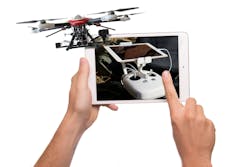How curious and innovative humankind can be when pressure situations arise. For some, tackling a perplexing problem and applying their skillsets to it is just another day in the life. Editor Maury Wright recently sent me a story that caught his attention from his local San Diego Union-Tribune, about two University of California‒San Diego (UCSD) professors from quite different disciplines working as a team with a graduate student on a drone modification —with the inventive twist of ultraviolet (UV) C-band emitting LEDs and artificial intelligence (AI) to disinfect spaces without people present.
Now we have been working away on various content offerings to educate folks on the truth about UV technology for disinfection, or what is sometimes called ultraviolet germicidal irradiation (UVGI) in the application sense. You may have attended last week’s webcast with LESA director Bob Karlicek, doing some myth-busting on the UV-C band, its properties, its background, and what sources are commercially available and the development path forward. Or perhaps you’ve been reading our blogs and commentary about the extreme uptick in interest for new tools in the fight against pathogens such as the coronavirus SARS-CoV-2. We know we’ve been covering it a lot lately – there is a lot of commercial work and also R&D happening right now to help make the world a safer place for all.
The team in this case — composed of Dr. Farsha Raissi, MD, assistant professor of cardiology; Tara Javidi, PhD, professor of electrical and computer engineering; and grad student Menglai Li — were motivated by the concerns for sanitation personnel’s exposure to potential pathogens while manually cleaning surfaces and materials. They considered the potential of UV-C to deliver a non-contact germicidal solution, which is in itself not a novel idea. But commercially-available mobile UVGI units may be too bulky or slow and unable to provide uniform irradiation of surfaces. So they put their ideas together in the DetecDrone lab at UCSD to equip the small unmanned aerial vehicles with UV-C emitting LEDs for UVGI, and are collaborating on refinements needed for AI to make the drones perform more efficiently and thoroughly via remote operation without humans present in the space. One of their priorities is determining the dose of UV-C that will be needed when operating drones in such a manner, considering airflow and proximity to surfaces and such.
This is a compelling example of sketching out a potential solution whose moving parts pretty much already exist, and finding ways for interdisciplinary experimentation to bring new capabilities to fruition. I look forward to hearing more about the outcomes of this project. You can read the Tribune article and also check out the DetecDrone lab page for updates on the UVGI experiments.
For up-to-the-minute LED and SSL updates, why not follow us on Twitter? You’ll find curated content and commentary, as well as information on industry events, webcasts, and surveys on our LinkedIn Company Page and our Facebook page.





